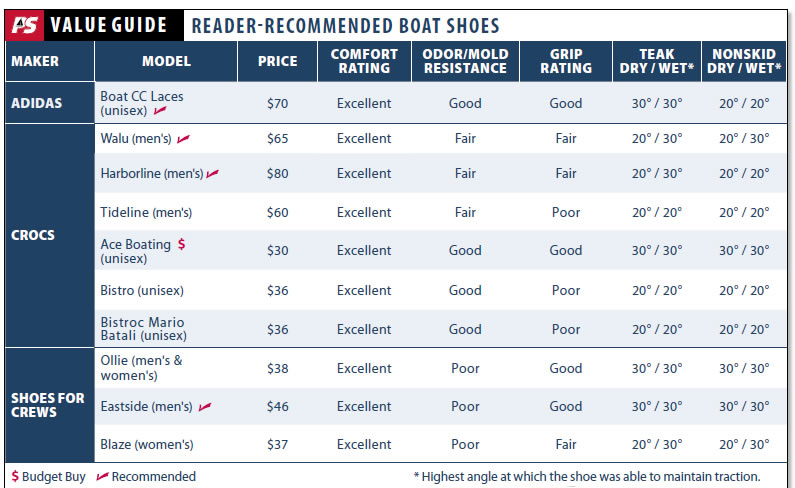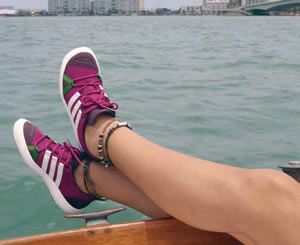
Whenever we report on sailing shoes or sandals (PS, Sept 2010, July 2010, June 2007, July 2007, Dec 2007), we get a heap of reader mail with recommendations for grippy, comfortable foot protection fit for sailors. Recently, the top reader-recommended shoes included styles from Crocs and Shoes for Crews. Curious to see whether these would measure up to our sailing-shoe criteria, we rounded up a few models from each maker. We added Adidas Boat CC Laces water shoes to the fray since they are the sportswear giants first foray into marine footwear. In total, we collected 10 different styles and put them through our standard shoe-test methods.
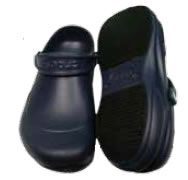
What We Tested
Our test field comprised mens, womens, and unisex shoes from the three manufacturers. Crocs-a 10-year-old company best known for its iconic, plastic-looking clog-style shoe-now offers more than 300 different styles, including one that resembles a sailing moccasin. Shoes For Crews (SFC), based in West Palm Beach, Fla., began making slip-resistant, low-cost footwear in 1984. SFC manufactures shoes for specialty markets like food service, factory, and health-care workers, and is well-known in those industries for making super-grippy shoes. Adidas, a global leader in the sporting goods industry for 80 years, is best known for making good-quality, stylish outdoor apparel.
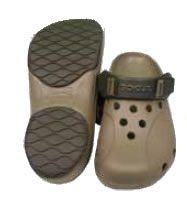
How We Tested
For this test, we followed the same test protocol and rating guidelines we used in past shoe tests. We evaluated each shoe on comfort, construction quality, foot protection, grip on an incline, draining ability, and resistance to odor and mildew.
Grip ratings were determined by having testers don each pair of shoes and stand on an incline testing device. The tests began with an incline of 20 degrees and progressed intermittently to greater angles of heel to find out at what point each shoe lost traction. We repeated the process for each shoe on wet and dry teak and nonskid panels.
To assess the shoes resistance to mold and odor, we soaked them in salt water, and then put them in a black plastic bag for a week.

Crocs
Constructed from Crocs trademark Croslite material, the original clog-style Crocs were hugely popular when they first came out and were known for being comfortable, odor-resistant, and waterproof. We tested three of the companys newer, more stream-lined clog designs (Bistro, the Bistro Mario Batali Edition, and Ace Boating Crocs) and three more nautical-looking Crocs (Harborline, Tideline, and Walu). All have non-marking soles.
The Bistro and Bistro Mario Batali styles were designed for food service, hospitality, and health care workers. (The Mario Batali line is named after the famous American chef and restaurateur.) Both feature Crocs Lock tread, which was developed to meet slip-resistant standards in these industries. Their enclosed toe and a thick metatarsal area protect feet and toes from bumps and spills, while a contoured, orthotic foot bed is designed for odor resistance and a comfortable, ergonomic fit. The shoe body and strap are molded Croslite, a proprietary foam resin that is lightweight, water-resistant, easy to clean, and durable. The absence of metal on the shoes and their tough, waterproof Croslite material make them seemingly fit for use in the marine environment. However, testers noted that the lack of lateral support and the flip-flop-like foot-shoe disconnect when stepping made these more clumsy to wear when scrambling across a deck. Even though these are streamlined clogs, they were a challenge to surefootedness.
Unlike the Bistros, the Ace Boating shoes are vented along the sides and tops. Vents not only allow water to drain, but they allow more airflow in the shoe, which keeps feet from sweating and odor-causing bacteria from growing.
The Bistros Lock tread was designed for traction on a flat surface-like a greasy restaurant floor-and testers noted that their nonskid ability suffers when worn on an incline. In our tests, they began slipping just beyond 20 degrees on wet and dry nonskid and teak. However, the Ace Boating shoe, which has a Velcro-adjustable heel strap, held on up to 30 degrees-a performance on par with some of the recommended shoes in our past tests.

The mens Harborline shoe has boat-moccasin styling with a leather upper and a medial arch vent for breathability and draining. There are four small vents on the shoe bottom, but testers would prefer them to be larger and would like to see side vents added. The Harborlines have different traction than the clog styles we tested, and they fared slightly better in the incline test. They also have removable insoles and an attractive look, but leather laces tend to dry and break over time.
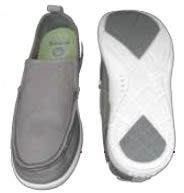
The Walu have a canvas upper body with a durable rubber outsole and tread that earned a Good rating in traction tests. They have removable, cushiony microfiber inserts with small holes for drainage, metatarsal and medial arch ventilation, and a Croslite midsole for extra cushioning. Testers liked the slip-on styling of the shoe but questioned the durability of the canvas upper in a marine environment. The canvas material will also stay wetter longer than some others we tested.
Crocs Tideline slip-on loafers feature a water-resistant upper, a Croslite sole, a removable insole, vent ports in the sole and sides, and a helpful back tab for donning the shoes. Like their clog-style brethren, the Tideline shoes had a less-than-stellar showing in the incline tests compared to top picks from past tests.
All Crocs offer a 45-day warranty. The shoes can be easily washed in cold water with a mild soap, but Crocs recommends limiting their exposure to heat, which can cause the shoes to shrink or warp. Prices of the ones we tested ranged from $30 to $80.
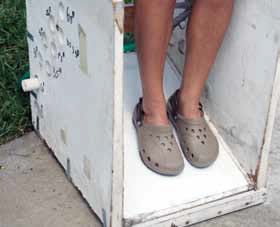
Bottom line: Although the clogs Croslite material is a good fit for a wet, slippery environment, their Lock tread didnt prove to be the best match for slippery inclines. The leather and canvas styles wont be as durable in the marine environment, but they are more breathable, and have more vents, better traction, and removable insoles. While the Walu had slightly better traction and pull-on tabs, testers liked the vents, drains, and nautical styling of the Harborline; these earn our Recommendation. Our favorite clog Crocs was the Ace Boating shoe. It was recently discontinued, but you can still find pairs online for about $30; it earns the Budget Buy pick.

Shoes For Crews
Testers looked at three styles of shoes from SFC: the Ollie (in mens and womens), the mens Eastside, and womens Blaze. (The Ollie and Eastside come in mens and womens sizes, with no discernible difference.) Because SFCs shoes are designed and manufactured by the company, they are sold at factory-direct prices. Many of the 80 styles cost less than $30.
The slip-resistant rubber compound soles have a patented Mighty Grip Outsole, and the tread pattern is designed to channel liquids away from the bottom of the sole. The tread comes with solid research behind it, and was rated highly in independent slip-resistance tests, even when tested on smooth, wet, Crisco-coated restaurant floors. The Practical Sailor readers who recommended we check out SFC reported that their traction was exceptional.
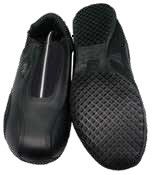
The Ollie and the Eastside shoes received slightly higher grip ratings than the other SFC shoes, and all of the SFC shoes had better gription than all of the Crocs except the Ace Boating model.
The SFC shoe designs are very basic, with few styling details. They are well made, comfortable, and affordable. All have great foot support and removable insoles. The downside to the shoes is that they are not designed for the outdoors, much less the marine environment. They have no vents or any system for water drainage, and once these shoes get wet, it takes quite a while for them to dry. This water-retaining characteristic also means they can mold and mildew more readily than the Croslite and Adidas models. They all earned Poor ratings for odor and mold resistance, except the Ollie, which had Fair mold resistance.
They come with a risk-free 60-day guarantee.
Bottom line: With heavy construction and no vents or drains, the shoes lack the breathability and drainage required in a boat shoe. The SFC shoes, which would be excellent for service workers, wont appeal to most sailors seeking a versatile boat shoe. However, large-boat owners looking to outfit a full crew with sturdy, grippy shoes may find the lower-priced SFC styles to be a worthy investment. The Eastside model edged out the others with a slightly more comfortable fit.

0)]
Adidas
After testing the neutral-colored, basic designs by SFC and Crocs, testers were eager to check out the colorful Adidas Boat CC Laces to see whether the trendy shoes substance would equal their style.
The unisex, lightweight, snug-fitting shoes have quick-drying, mesh-like uppers and grippy outsoles designed for traction on wet surfaces. The mesh fabric, along with screened ports on the shoe bottom, allow for maximum ventilation and water drainage. Details that testers liked included protective rubber around the toes and neoprene and pull-on tabs at the heels for easier donning.
The Adidas performed well on wet surfaces in the incline tests, but showed average grip on dry teak and nonskid.
The Adidas shoes come with a six-month warranty, the best of the bunch.
Bottom line: The most sailor-oriented of those we tested this round, the Adidas gets PSs Recommendation.

1)]
Conclusion
When it comes to grip, none of the entries in this test outshined our previous top picks like the Teva Helm 2, Columbia Outpost Hybrid, Teva Sunkosi, Timberland Eurus Low II, and Sperrys Figawi2. However, the shoes in this round are less expensive than our past picks, so we can recommend a few as budget-friendly alternatives.
Although clog-style Crocs are somewhat clunky when moving about the deck, the Ace Boating clog was one of the top grippers in this test and its Croslite material is well-suited for on-board duty. The discontinued Ace, which is still available from some online retailers, got the Budget Buy pick. Crocs’ Walu and Harborline offer average traction in tests, but their comfort, foot protection, and styling earn them a recommendation for sailors looking for a boat shoe that doubles as a shoreside casual shoe.
Testers liked the SFC entries top-notch quality and affordable price, but their lack of vents, drains, and quick-dry materials kept them out of the winners circle. However, if youre looking for a cheap way to outfit a full crew, we Recommend the SFC Eastside, one of the tests top grippers.
The Adidas styling was more in line with a typical boat shoe. Although the bright colors wont appeal to everyone, the lightweight, breathable, and well-ventilated Adidas did comparatively well in traction tests. It gets testers heartiest recommendation for a budget-priced boat shoe.
For details on past winners, which remain our top picks, check out the September 2010, July 2010, December 2007, July 2007, and June 2007 reports.
